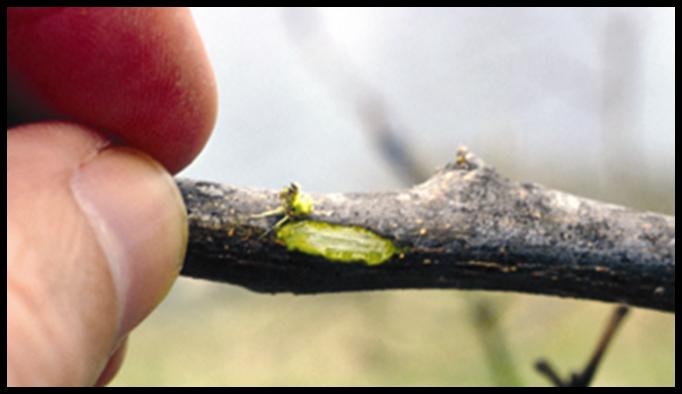
by Roy Carter | Jan 20, 2014
January and February are typically the coldest months in Florida and plants can be damaged by low temperatures. But with your help, cold-damaged plants can often recover.
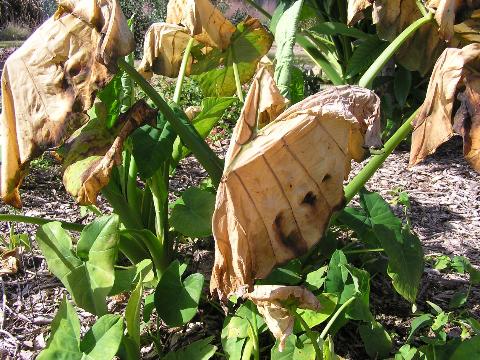
Cold damage on Ornamental. Image Credit Eddie Powell UF IFAS Extension Walton County
After a freeze, see if your plants are dry. Even injured plants need water.
Plants, however can be greatly damaged if the temperature drops suddenly. They have no time to acclimate to the freezing temperatures. Plants are damaged when ice crystals form the plant cells. The crystals expand, rupturing the cell walls and preventing the plants from maintaining shape. If severe, this can kill tender plants. On hardier plants, damaged foliage will appear wilted and curled down. In a few hours or days, it will darken and turn black. Flowers and buds my die, blacken, and drop to the ground if exposed to cold temperatures. Damaged flowers will not develop into fruit. Young branches and new growth are especially susceptible and may also blacken and die.
After freezing temperatures occur, remove damaged leaves and flowers as soon as they turn brown or black. This will help prevent diseases from attacking the plant. Pruning should be postponed until cold temperatures are no longer expected and new growth begins to appear on the plant. This is to make sure that live wood, which appears dead from losing its leaves, is not mistakenly removed from the plant. Cold damaged wood can be detected by examining the cambium layer (under the bark) of the plant. If it has black or brown discoloration, it is damaged and should be pruned back behind those points.

Living cambium layer beneath bark. Image Credit UF IFAS Pinellas County
Protect your plants from cold temperatures during the next cold front. Do this by moving potted plants indoors and covering tender landscape plants with a protective covering. Protective covering can include old bed sheet, pieces of material or fabric, and cardboard boxes. Be careful not to let the protective covering touch the plants. The surface of the covering will become as cold as the air temperatures and may damage any tender leaves it come in contact with. Also, don’t forget to remove the covering the next day when temperature raises this is important so the plants do not “bake” in the warmer temperatures. Plants placed near the house, lights, or other structures, which shelter them from wind, will be more protected than those fully exposed to the cold air.
Whatever you do, even if your landscape ornamentals have already suffered some cold injury. Do not relax your guard more frigid weather may be on the way. So, be prepared to keep your prized plants, as warm as possible, each time the weatherman predicts freezing temperatures. Plants should be fertilized in the spring, to encourage new growth. Try not encouraging any new growth, until all frost danger has passed.
For more information on freeze damaged plants contact your county extension agent and see Publication The North Florida Gardening Calendar
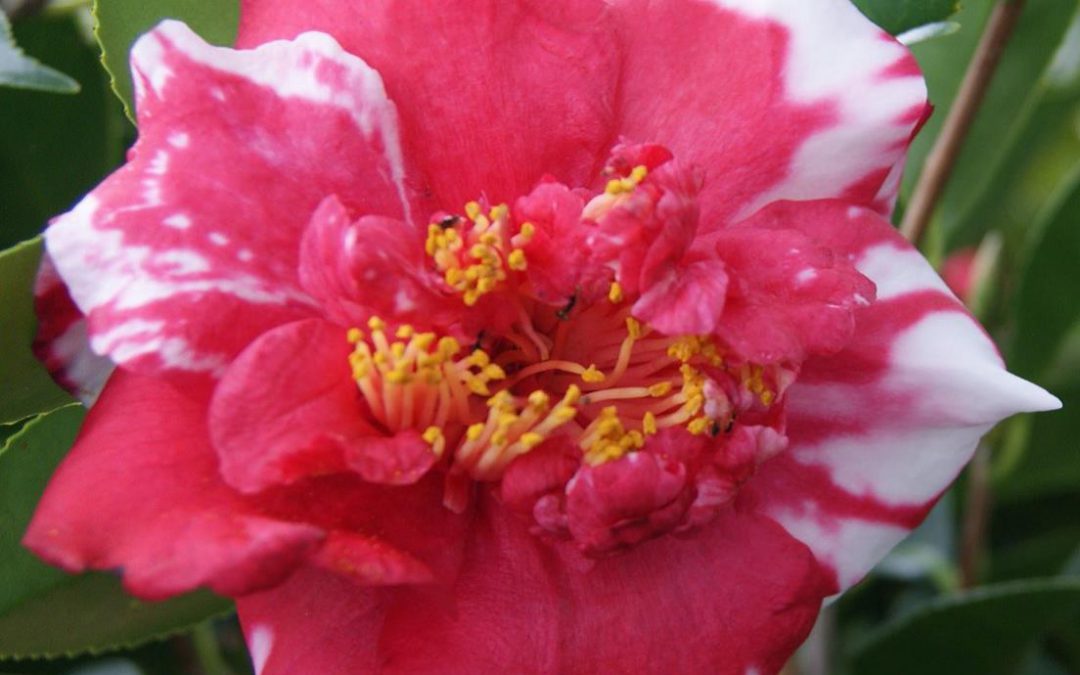
by Matthew Orwat | Jan 14, 2014
Want to learn how to graft Camellias?
Graft your favorite cultivar onto an adapted rootstock!
Saturday January 18th 9:00am – 12:00pm CST !
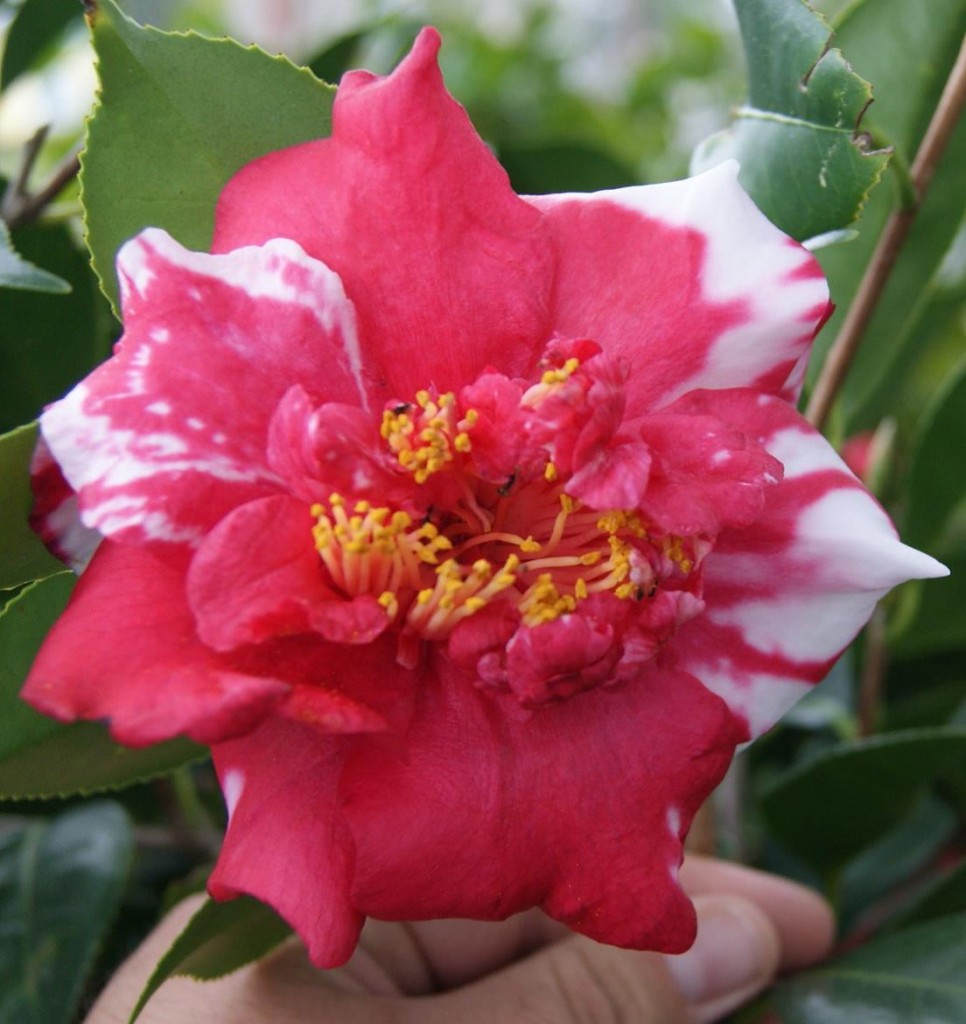
- Join us to learn how to graft your favorite camellia cultivar onto an adapted rootstock
- You can take home your own grafted camellia
- Hosted by Maphis Tree Farm and UF IFAS Extension Washington County
- You will engage in hands on grafting of Camellias for your gar-den. You will take home a grafted Camellia of your own All sup-plies will be furnished by Maphis Tree Farm at a cost of only $30.00 per person
- Maphis Tree Farm 1534 orange Hill Hwy Chipley, FL.
- Call or Email Maphis Tree Farm toregister at 850-638-8243
 maphistreefarm@bellsouth.net
maphistreefarm@bellsouth.net

by Carrie Stevenson | Jan 14, 2014
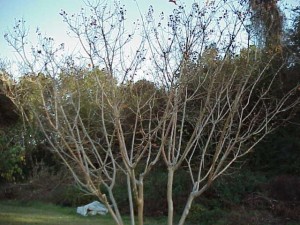
The branching structure of crape myrtles makes an impact to landscapes even in winter time. Photo credit: Beth Bolles
Most people associate yard work with the spring and summer, but if you’re considering a major redesign of a home landscape, now is a great time to start. Without the vegetation on deciduous trees, it’s easy to see the “bones” of your yard—the tree trunks and branches, sidewalks, and fences—which frame it.
One of the best ways to start with landscape design is a piece of paper and pencil. If you’ve got a paper copy of your survey, even better—you can sketch in trees, sidewalks, and fences with an aerial view and see where the open spots lie. Take some time to walk around your yard, considering how you use the space. Do you have children or pets that need room to run? A shady area for relaxing? Full sun for a garden? All of these uses can co-exist in a single yard, but the key to good landscape design is allowing for them to flow together in a logical, attractive way.
If you’ve never put together a comprehensive landscape design before, there are several very helpful tools online provided by horticulture experts with UF IFAS Extension. The “pattern guide” is ideal for starting and completing small projects, such as side yards, shade areas, etc. and even suggests appropriate plants based on light conditions and region of the state. Using this guide is a great way to start from scratch and build up to a diverse, healthy landscape. On the other hand, if you are essentially satisfied with your yard but just need a few accent plants or another tree somewhere, a great online resource is http://floridayards.org/. Here, you can enter a set of specific criteria based on the type of plants you’re looking for, and the site will create a customized list of suggestions to use in your landscape.

The online Florida-friendly landscaping pattern book has great ideas for redesigning your landscape.
After deciding on additional needs for hardscape and plantings, the next step is to make room for them by removing sod or unwanted landscape plants. Now is also the time to look at irrigation needs—if you have an existing system, make sure it still works with your new landscape design. If it doesn’t, it’s much better to redirect water, piping, or add new sprinkler heads while you’re digging into the soil than after you’ve finished installing new vegetation. If you aren’t using an irrigation contractor, you’ll need a solid understanding of how the system is set up before making changes. Inexpensive kits can also be purchased to add drip or micro-irrigation to an already-installed system.
Once irrigation and hardscape are complete, you can begin with plant installation. It makes the most sense to plant trees first, add mulch around the root zone, then put in shrubs and groundcovers based on your plan. Many do-it-yourselfers will take their time on this step, adding new plants as time and budget allow. This method works well and can be a fascinating way to watch your yard transform.
We have many great resources for more in-depth discussion of landscape design and irrigation work, including your local UF IFAS Extension office. Don’t hesitate to call us with questions or send photos of your new and improved yards!
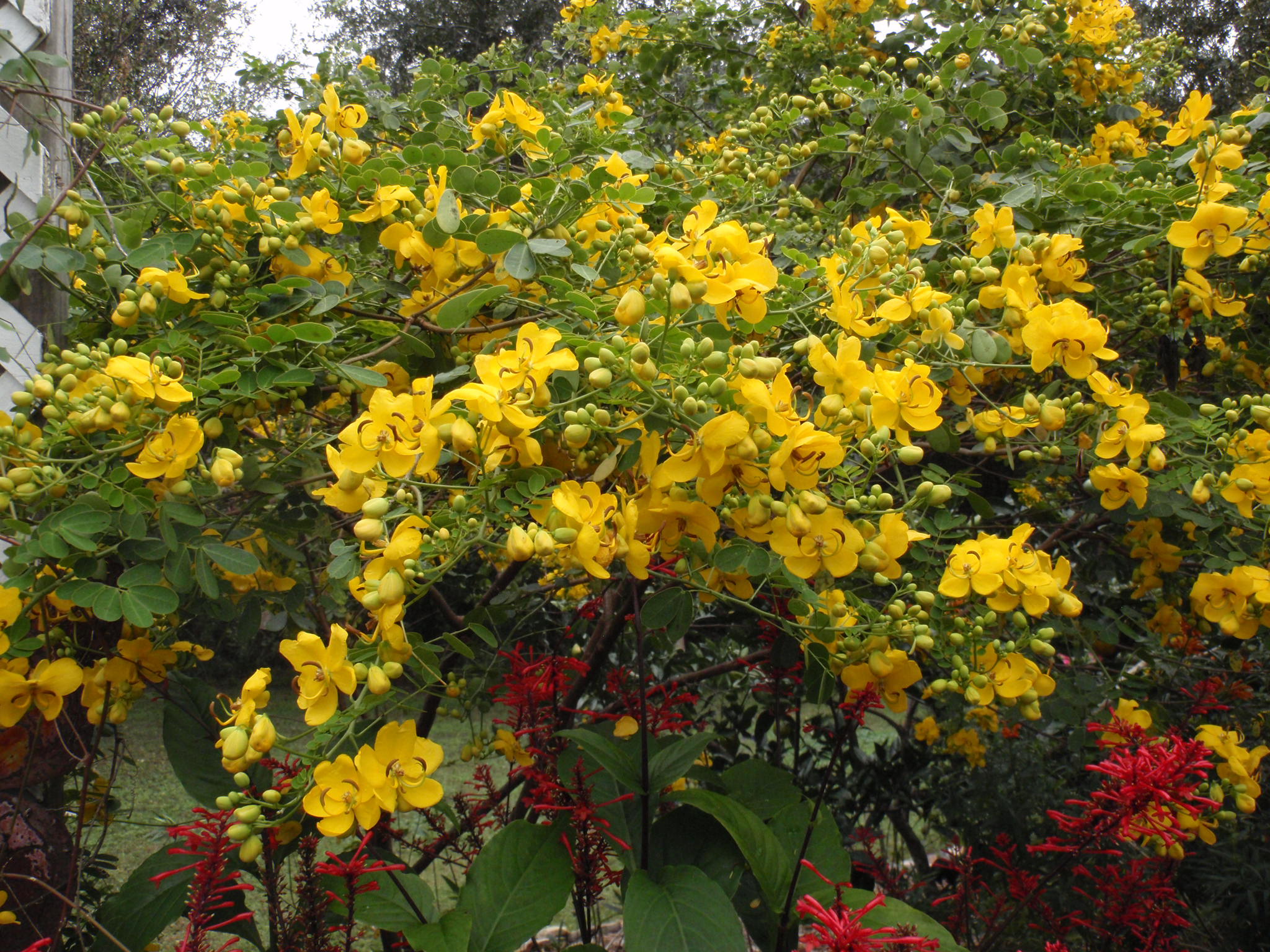
by Beth Bolles | Jan 14, 2014
Trees and shrubs often serve a distinct purpose in landscapes, other than to provide color. They are planted to provide shade, screen a view or noise, or to soften the hardscapes of the home.
With a little planning, we can have both beauty and function from trees and shrubs. Add a few trees and shrubs that have color in different seasons and your landscape will always be interesting.
The added benefit of growing trees and shrubs is that they are low maintenance. Once the plants are established in the landscape, they will require very little water and only an occasional application of a slow release fertilizer. A good layer of an organic mulch around the plants will help conserve moisture, prevent weeds, and keep root temperatures regulated during our temperature extremes. You may have to do a little pruning every year to remove any diseased, damaged, or severely crossing branches.
Here is a list of plants to give you garden interest throughout all seasons:
Winter color
- Taiwan cherry (Prunus campanulata) is an underutilized ornamental cherry for the coastal south. Clusters of dark pink flowers cover the plant which grows about 20 feet.
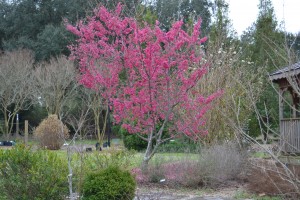
Taiwan cherry
- Camellia japonica is widely used in landscapes, but still an excellent choice for winter color. Careful selection of types will provide a garden with color from November through April.
- Red maple (Acer rubrum) will provide color in both the late winter and fall. Flowers are brilliant red in late winter and leaves begin turning red in late October.
- Other choices include Oakleaf hydrangea, Florida anise, Red buckeye, and Japanese magnolia
Spring
- Fringe tree (Chionanthus virginicus) can be in shrub or tree form and range in height from 10 – 20 feet. Forms white clusters of showy fringe-like flowers in late winter and early spring before the leaves emerge.
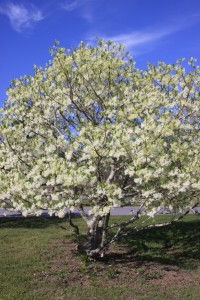
Fringe tree
- Chinese fringe (Lorepetalum chinesis ‘Rubrum’) is a very popular shrub. Pink blooms are heaviest in the spring. The plants can get up to 12 feet in height so plant it were it will not obstruct a view.
- Virginia sweetspire (Itea virginica) forms clusters of white flowers. Plants offer purplish foliage in the fall.
- Other choices include Banana shrub, native azaleas, Indian hawthorn, and Deutizia,
Summer
- Chaste tree (Vitex agnus castus) is a large shrub with fragrant leaves and spikes of purple flowers. Tolerates drought and develops interesting shape.
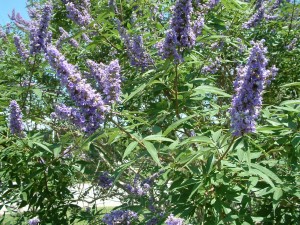
Chaste tree
- Loblolly bay (Gordonia lasianthus) is an evergreen tree that grows to 25-35 ft in height. Large white flowers with yellow stamens resemble camellia blooms.
- Abelia spp has white flowers that appear over the entire plant. It is attractive to butterflies .
- Other choices include Crape myrtle, Althea, Confederate rose, and Oleander
Fall
- Bald cypress (Taxodium distichum) will become a large tree over time. In the fall the feathery leaves will turn orange-brown. Good tree for both wet and dry areas.
- Beautyberry (Callicarpa americana) a native that forms clusters of purple berries that line the stem. Leaves turn yellow and provide fall interest as well.
- Cassia bicapsularis can reach 8-12 ft in height and will have bright yellow flowers that form in October and persist until a freeze.
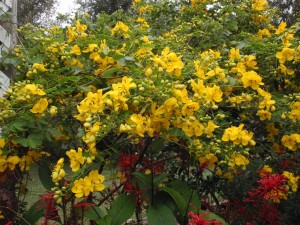
Cassia
by Julie McConnell | Jan 13, 2014
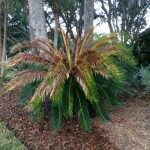
King Sago Palm. Photo credit: Mary Derrick
The wordpress-platform version Gardening in the Panhandle began in May of 2012 and had 188 views from its inception through the end of the year. This was a new online version of a long running and award winning traditional print newsletter. 2013 brought a new e-newsletter format and a ramped up effort to provide science based articles that you, the reader, find interesting and useful as you garden in the panhandle. We have gotten your attention, you visited Gardening in the Panhandle 23,422 times in 2013!
Below is a list of the top fifteen most read articles from 2013 with links so that you can visit again if you missed it. Please let us know if there are topics you would like to see covered by leaving comments or emailing one the editors Matthew Orwat mjorwat@ufl.edu or Mary Derrick mderrick@ufl.edu.
# of Hits Title Author














